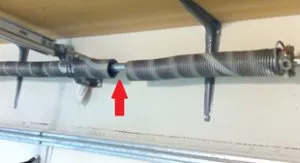
If you’re present when a garage door spring lets go, you’ll know something has happened, because you’ll hear something that sounds a lot like a gunshot – or at the very least, a loud thump. Then, if you look up, you’ll see that the spring above the door has snapped. You might think, “That looks like it would be pretty easy to fix,” and put replacing the garage door spring on your weekend “to do list.”
Please think again. This is not something you want to attempt on your own – the spring system is what supports the entire weight of your garage door, which can be as much as 136 kg (about 300 pounds).
What are the different types of garage doors?
- The spring is contained in a tube that is located over the door;
- If the spring breaks, it will remain suspended from tube.
- The door springs are situated above the horizontal tracks;
- If a spring breaks, assuming that a safety cable is part of the assembly, this safety cable will prevent the spring from completely detaching and landing on the floor.
With both the torsion and extension systems, the springs serve as counterweights to the actual weight of the garage door. The springs serve to reduce the weight of the door as it is being opened to 3.5‑4.5 kg (8‑10 pounds). This is why, if you need to lift the garage door manually, it is not difficult.
How long should a garage door spring last?
Usually, you can expect to get 5‑7 years of use out of a 10,000 cycle door spring. 10,000 cycles might sound like a lot, but when you consider the number of times in the run of a day that you open and close your garage door, it adds up quickly. We also have double‑life springs that will last 20,000 cycles.
Why shouldn’t I change a broken spring?
Let’s talk about how the lifting system of your garage door works. With a torsion system, the spring is attached to a tube, which in turn is attached to a drum. The drum’s purpose is to wind the lifting cables. The cables are affixed to brackets that are located at the bottom of the garage door. When the garage door is closed, the lifting cable is wound tight, something like a guitar string.
With an extension spring system, things are interconnected in much the same way. The only difference is that there is no tube.
Now, if you have a two‑car garage, the total weight of the garage door is going to be considerably greater than it would be for a single‑car garage. The tension exerted upon the lifting system is also going to be greater. It’s rare for both springs to break at the same time, but it can happen.
So I’ll just use my electric door opener – no worries!
Depending on the strength of your garage door opener (½ or ¾ HP), you are correct to some extent. However, keep in mind that garage door openers are made to lift up to 110 kg (250 pounds) or more. And a garage door is going to weigh exactly the same coming down as it does going up, so you definitely do not want to be standing under that door when it comes down.
So what can I do about a broken spring?
If you do have an electric door opener, first close the garage door. Then unplug the opener from the electrical outlet. Contact us right away – you should consider this to be an emergency repair, as a broken spring presents a huge safety issue. You should only use the electric door opener if an emergency occurs and you have no alternative but to leave your home by way of the garage.
Are there any preventive measures I can take to avoid this sort of situation?
Yes. Every six months, you should inspect and lubricate your garage door. Check for signs of wear or other damage, and lubricate any metal parts that come into contact with one another – the springs, rollers and hinges. The best times to do this would be in early spring and again in late fall – remember, your garage door gets the most use during the winter months.
A bit of oil for metal is all you need to lubricate the springs. This will protect them against surface rust, and also reduce the sound that the coils make when they rub together. It will also make the springs last longer.
Do you do inspections and maintenance?
We sure do! We offer a thorough 28‑point check‑up service for your residential garage door. We will inspect the door, make any necessary adjustments, and lubricate the moving parts. If it looks like a component should be replaced, we will let you know and also provide you with a quote before proceeding with the work. We will also give you a complete report on the condition of your garage door.
When you need service, repairs, or a new garage door or electric opener, you can schedule a service call online or get in touch with us by phone at 515-276-3700 for a free quote. And don’t forget to check out our Design Centre, which is an online tool that lets you design your ultimate garage door!

Add new comment